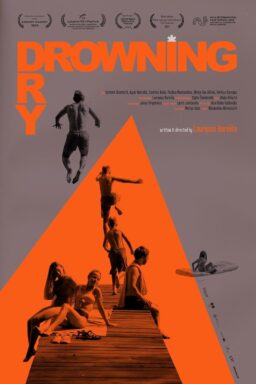Paul Verhoeven‘s “Benedetta” was inspired by an account of the life of Sister Benedetta Carlini, a 17th-century nun who claimed to have had religious visions and was investigated both as a possible faker and for having had a lesbian affair with a fellow nun. Few movies could be more relevant to Verhoeven’s interests. In his telling, Benedetta (Viriginie Efira) is more fun as a mystery not quite solved. Like Sharon Stone’s Catherine Tramell in “Basic Instinct,” she keeps a straight face when insisting that she’s telling the truth, and certain people want to believe her. Did she fake her stigmata with a shard of glass? Did anyone see it? We’re back in the realm of Catherine’s ice pick.
The glass shard isn’t even the most significant object in the movie. That would be a small statue of the Virgin Mary brought to the convent by Benedetta as a girl. One character’s proposal for how that statue might be used got a round of applause from the Cannes press corps, which, at least in my case, came prepared to be shocked by this competition film’s blasphemy and explicitness. Verhoeven, still courting scandal at 82, did not disappoint.
An amateur historian of Jesus (he wrote a book) whose movies have expressed a consistent skepticism of religion, Verhoeven gives most of his sympathy, at first, to Sister Christina (Louise Chevillotte), a nun who doubts Benedetta, and Sister Felicita (Charlotte Rampling), a doggedly practical abbess who seems more committed to collecting dowries than to her calling. (“A convent is not a place of charity,” she scoffs, in another line that got a laugh.) If Verhoeven’s other movies have given us what the critic J. Hoberman has called “non-Christian Christs,” now the director gives us nuns who believe most of all in secular reasoning.
But as a master of the erotic thriller, Verhoeven is naturally drawn to the relations between Benedetta and Bartolomea (Daphné Patakia), who arrives at the convent more knowledgeable than Benedetta about sex, albeit for horrifying reasons. (She was raped by multiple family members.) Despite being under Benedetta’s supervision, she appears to be the more confident of the two. Her provocations of Benedetta and the reprisals (with Bartolomea boiling her hand in a show of defiance), and the duel between blonde and brunette, sometimes suggest a 17th-century replay of Elizabeth Berkley/Gina Gershon rivalry in “Showgirls.” (As to how the Foley editors made the sex scenes sound that way, I’m at once intrigued and really don’t want to know.) Again, anyone who would regard a portrait of conspiring, defecating, and frequently naked nuns as a religious affront should stay far away from this movie. Benedetta’s sexualized visions involving Jesus may or may not be consistent with her real-life claims, but “Benedetta” is a film that seems likely to provoke outrage in certain quarters.
Not quite as bananas as “Flesh + Blood” (1985), the last Verhoeven movie in which a group of self-proclaimed visionaries played footsie with the plague, “Benedetta” is nevertheless a more accomplished film. At times, it has the feel of a grand summation of all the director’s ideas about eroticism, rationality, moral ambiguity, and faith. At once tongue-in-cheek and entirely serious, it is a religious movie in which an ostensible sign from above arrives in the form of a man getting bird poop in his eye, and the noblest way to burn at the stake is essentially to sterilize your contagious body while it’s decaying from disease.
The title “The Worst Person in the World” does not refer to Paul Verhoeven. Rather, it’s the new film from the Norwegian director Joachim Trier. If his “Oslo, August 31st” (2011) was essentially a pushing-30 movie in which the protagonist just happened to be a drug addict, “The Worst Person in the World,” showing in competition, is a pushing-30 movie about another character whose impulses send her life spinning of control. More precisely, her problem is that she is serially impulsive: Julie (Renate Reinsve) trains to be a doctor only to decide that practicing medicine is too mechanical; she’s really interested in the mind, so psychology it is! Then it’s a complete change of pace, to professional photography. She works in a bookstore in the meantime, and maybe she’s a natural writer. Her boyfriend thinks her essay on oral sex in the era of #MeToo shows promise. Her father tells her that he had trouble opening the attachment.

To be honest, I don’t think “The Worst Person in the World” ever figures Julie out—or at least fleshes her out to the point where I was convinced she could subsist like this in real life. Although her long-term boyfriend Aksel (Anders Danielsen Lie, from “Oslo, August 31” and Trier’s earlier feature, “Reprise“) is a graphic novelist who seems well-off (he has a movie deal in which the filmmakers have dumbed down the raunchy feline character he’s created into a children’s cartoon), but economics don’t seem to enter her mind. It’s not that money should be a pressing concern for her—part of the point is that her decisions have left her treading water in the bookstore—as much as it is that it doesn’t ever seem to be a concern. I did wonder if a world beyond Oslo exists for Julie or any of these characters. The movie is derivative (the early scenes, especially, play like Trier’s spin on “Hannah and Her Sisters“–era Woody Allen). And it really kind of drags.
But there are just too many treasurable things in “Worst Person” for me to keep complaining, and they start with Reinsve, who embodies a mix of flightiness and confidence that enables Julie to drift through life without an anchor. (She isn’t actually the worst person in the world, but her whims can have cruel knock-on effects.) Danielsen Lie, too, is superb as Aksel, who is more than a decade older than Julie. He has one scene in particular in a kitchen in which he somehow finds just the right tone to respond to Julie, and in a few lines gives the impression that these two people know each other about as well as two people can.
The movie has moment after moment of offhand charm and humor. Julie crashes a party and informs a mother who is talking about cuddling with her children that cuddling is bad for kids, and adds that she’s speaking from a medical perspective. (To be clear, this is after Julie has switched to photography.) She and another party guest, Eivind (Herbert Nordrum), meet and then flirt until dawn; they’re both involved with other people and continually redefine the boundaries of what qualifies as not cheating. Later, Julie is the first of a group to ingest psychedelic mushrooms and has a trip that definitely leaves a mark in the morning. There’s an almost inexplicably moving scene of Julie, at the gym, watching Aksel on TV as he defends his right as an artist to be offensive, and seems to understand him in a new way. And the epilogue—which, judging from the actors’ surgical masks, was shot during the pandemic (perhaps as a late addition to the narrative?)—finds a closing note that is unexpected, yet true to everything that came before. I’m not sure I can defend “The Worst Person in the World” on an intellectual basis, but I was thoroughly disarmed.












